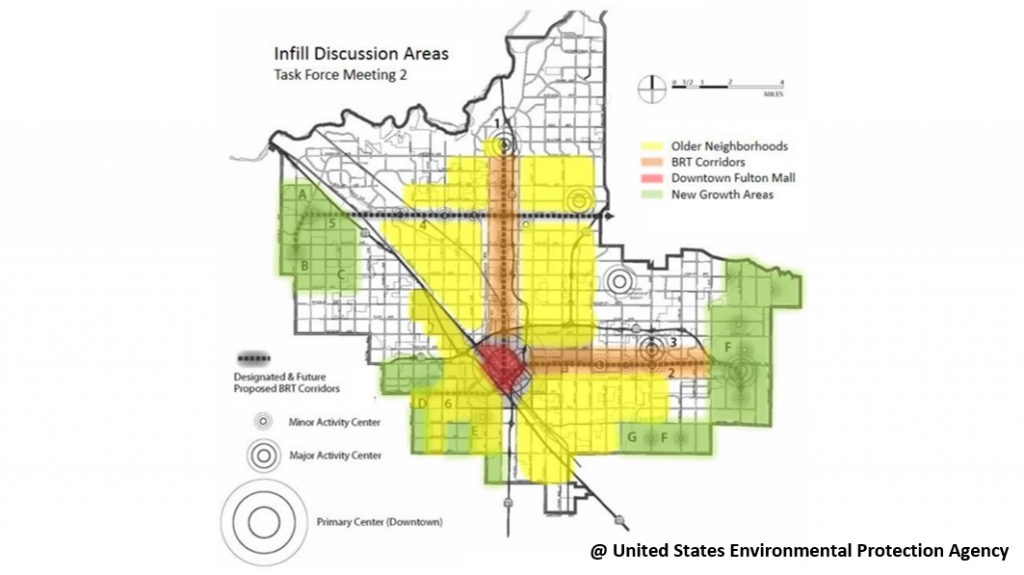
1. Presentation
This measure aims to deal with the consequences of urban sprawl, a phenomenon that promotes the creation of extensive and automobile dependent cities. These sites impose great pressures on the pre-existing natural systems and create accessibility and equity issues for their residents.
The measure divides itself into two components, the imposition of restrictions to hinder the creation of dispersed neighbourhoods and the intervention in existing neighbourhoods to rectify some of the issues created.
The first component is more suited for shrinking cities. It introduces restrictions to the planning instruments in effect to avoid that areas with few services, namely public transports, can increase in density throughout the years, escalating the dependence on the automobile and creating accessibility and traffic problems.
The second component promotes the implementation of services and businesses on a local and distributed scale, creating short-distance accessibility, which promotes cycling and walking.
2. Objectives
- Avoiding the increase of urban perimeter and transforming low density areas in more compact and accessible neighbourhoods.
3. Measure’s Importance
By applying the necessary actions to limit urban sprawl, the growing dependence on the car is halted. Furthermore, promoting multiple and diverse functions reduces the need to use the automobile, reducing congestion levels, facilitating cycling and walking a, thus creating livelier and more sustainable neighbourhoods.
1. Good Practices
– Apply strategic and comprehensive plans, instead of implementing isolated decisions (See Connecting people and schools, Connecting people and public transportation, Car parking restrictions).
– Use the existing community resources.
– Create different types of residences for families of diverse ages, members and income.
– Promote compact neighbourhoods, accessible through walking and cycling.
– Encourage participation from citizens and intervening actors in planning decisions.
– Assure that land-use and transportation policies are coordinated.
– Encourage cooperation between public and private entities to assure these areas are developed.
– Monitor citizens’ adaptation to changes and reformulate measures to respond to users’ needs, without compromising sustainable ideals (See Management, monitoring and maintenance).
– Explain the principles behind the measures taken so that their need and functioning are clear (See Information).
2. Actions
| Urban sprawl restrictions | |
 | Urban perimeter restrictions Limit the capacity of adding new areas to urban perimeters to stop urban sprawl and, consequentially, not increase the use of private vehicles. The legislation should prioritize the densification of unconsolidated urban areas, instead of facilitating the construction of infrastructure in areas to sparse to assure their efficiency. Advantages: • Allows the consolidation of management efforts in denser areas. • Hinders spending in unnecessary infrastructure. |
 | Apply limits to construction Impose minimum and maximum limits to plot sizes to promote densities adequate to the existing public and non-motorized transports. Thus, sparse areas inside urban perimeters are prevented of becoming suburbanized, avoiding their dependence on cars. Advantages: Avoids the future creation of areas to dense for their infrastructure and all of the sustainable mobility issues associated with resolving it. Disadvantages: Coordinating between municipalities, contractors and planners may be difficult. |
 | Renovate fiscal, planning and managing practices Renovate measures that undervalue the cost of the car, hinder urban densification and undervalue the efficiency of non-motorized urban transportation. Specifically, practices that result in lower costs to constructing highways and low density neighbourhoods, which demand an exaggerated vehicle service area, an exaggerated number of barriers in the rehabilitation process and the underappreciating of non-motorized transports, leading to less investments in this area. Advantages: The implementation of these reformations will facilitate the creation of more sustainable, ecologic, pleasant and socially diverse neighbourhoods. Disadvantages: • The overall public and authorities have a great aversion to measures that restrict car use. • Coordinating between municipalities, contractors and planners may be difficult. |
| Rectifying urban sprawl areas | |
 | Prioritize diverse constructions in non-consolidated areas Implement legislation that promotes the rehabilitation of degraded areas and urban infill. These should be occupied with typologies that promote density and variety. By promoting the densification and diversification of existing neighbourhoods, one creates the conditions to facilitate cycling and walking. It is important that the legislation is specific enough to promote the construction of typologies that respond to the needs of the neighbourhood and not just the will of the real-estate business. This action needs to be associated with measures that restrict the urban perimeter to avoid urban sprawl and, thus, the use of the automobile. Advantages: • Reduces the risk associated to vacant and degraded areas. • Provides services needed. • Reduces spending in construction of infrastructures, since, instead of extending them outside of the urban perimeter, the existing resources are explored. Disadvantages: • If the construction is not properly managed, the surrounding properties, even the entire community, may be negatively affected. • If the legislation is not appropriate, it can lead to speculation, hence, gentrification. |
 | Maximize accessibility Localizing associated functions near each other, namely businesses, schools, public transports and residences. To do so, is necessary to allow the existence of industrial and commercial areas inside cities. Advantages: • Reduces the number of daily trips. • Facilitates access by cycling and walking. Disadvantages: • Some public acceptance issues may emerge due to fears of scarcity of car parking or other services. • If the legislation is not appropriate, it can lead to speculation, hence, gentrification. |
1. Impacts
 | Mobility system efficiency By promoting density appropriate to the existing transport systems, the car dependent population decreases, reducing traffic congestion and demanding improvements in the mobility systems. |
 | Livable streets Promoting varied and accessible businesses would facilitate walking and cycling, reducing car congestion and enabling safer and more pleasant public spaces. |
 | Protection of the environment Promoting non-motorized transports reduces pollution. |
 | Inclusion, equity and accessibility Promoting density and variety will allow the improvement of non-automobile accessibility, creating more equitable cities for those without means to own a car. Furthermore, promoting diverse housing options will facilitate the creation of diverse communities. |
 | Safety and comfort Reducing automobile traffic and promoting walking and cycling reduces the probability for traffic accidents and increases the self-surveillance of the neighbourhood. |
 | Economic value By allowing jobs to be located near residential areas, neighbourhoods become more economically resilient. |
 | Awareness and acceptability No impacts. |
Legend:
| Very positive | Positive | Neutral | Negative | Very negative |
3. Barriers
 | Legal In most cases, there are no obvious legal barriers to implementing cycling networks. |
 | Finance Planning and implementing a cycling network can be an expensive undertaking, although there is a substantial cost difference between cycle tracks, cycle lanes and coexistence. The need to prioritise scarce public funds for a minority of users (in the case of starter cities) is a significant barrier. |
 | Governance The implementation process may involve public authorities and potentially corporations, cycling charities and other interest groups. |
 | Political acceptability In starter cycling cities, as cyclists represent a minority, measures focused on bicycle often have less priority within the policymaking process than those measures related to motorised vehicles. |
 | Public acceptability Support from various groups as well as pro-cyclist lobbies is expected. However, it is also expected the reaction from those who are contrary to investments in cycling, especially if it undermines the investment in other modes of transport or public services. |
 | Technical feasibility The implementation of cycling infrastructure requires careful planning and design. Nevertheless, in comparison to other transport modes, technical requirements are not complex. |
Legend:
| No barrier | Minimum barrier | Moderate barrier | Significant barrier |
3. Budget
| Area | Measure | Unit | Cost | Implementation year |
| Moura, Beja (Portugal) | Acquisition of services to elaborate the revision of the Municipal Director Plan | 74 980,00 € | 2019 | |
| Loulé, Faro (Portugal) | Acquisition of consultancy services for planning and urbanistic management issues | 19 400,00 € | 2018 | |
| Paredes de Coura, Viana do castelo (Portugal) | Elaboration of the Paredes de Coura Local Housing Strategy, in the scope of the 1st Right – Support programme for housing access | 16 900,00 € | 2019 | |
| Vila Verde, Braga (Portugal) | Technical consulting in the urban rehabilitation area and execution of the urban rehabilitation strategic programme | 26 500,00 € | 2019 |
Case study 1: Fresno, California (U.S.A)

Fresno utilized an infill strategy to reverse the growing violence, poverty and pollution trend it was facing. The plan sought to reverse urban sprawl, which had been the norm up until then, by implementing densification measures in degraded areas.
The main objective was to rehabilitate the historic and economic centre. Thirty measure were applied, including:
- Identifying non-consolidated areas to rehabilitate;
- Reducing parking minimums in non-consolidated areas to promote sustainable mobility modes and reduce spending by not creating new parking spaces;
- Adopting flexible zoning codes to promote land-use alteration according to the evolving needs of the population;
- Provide clear renovation rules and specific rehabilitation codes for the historic buildings in non-consolidates areas, to facilitate their rehabilitation;
- Reduce legislative restrictions on construction density when it offers community wide benefits (equipment, infrastructure);
- Place public equipment in non-consolidated areas to attract new enterprises.
Learn more: www.epa.gov/sites/production/files/2015-05/documents/fresno_final_report_042215_508_final.pdf
Impact:
 | Mobility system efficiency No data. However, by promoting the concentration of functions, the design of public transportation routes is facilitated and the number of necessary automobile trips is reduced, reducing congestion. |
 | Livable streets Concentrating functions in the historic areas facilitates the encounter between residents, promoting community spirit and reversing the insecurity trend. |
 | Protection of the environment The plan was designed to reduce the need of using a private vehicle to reduce the high levels of air pollution that had been registered. |
 | Inclusion, equity and accessibility By promoting new enterprises, the aim was to improve work conditions and reduce the poverty levels. Furthermore, by reducing the need to use a car, the city becomes more inclusive for those who cannot afford one. |
 | Safety and comfort Promoting a community spirit and improving the safety conditions in gathering areas will reduce insecurity. |
 | Economic value Integrating mixed used areas, including shops, offices, services and industries, increases the economic resilience of the neighbourhood. |
 | Awareness and acceptability No data. |
Case study 2: New legal Framework on the Portuguese Land-use (Portugal)
The Basic Law for Public Policies on Soil, Territorial Planning and Urbanism (Lei de Bases da Política Pública do Solo, do Ordenamento do Território e do Urbanismo – Lei n.º 31/2014, de 30 de maio) and the consequent revision of the Judicial Regime on Territorial Management Instruments (Regime Jurídico dos Instrumentos de Gestão Territorial – Decreto-Lei n.º 80/2015, de 14 de maio) introduced a new point-of-view on land classification in Portugal.
Land-use definitions were rewritten to restrict buildable areas and new subcategories for urban and rustic were introduced, in order to define different areas according to their density. As a result, high density construction in areas with no sustainable infrastructures or services are limited.
The new definitions on urban, rustic and their subcategories are wide-ranging to allow for the different circumstances of each municipality. However, the “rational and efficient use of land, as a scarce natural resource” and the containment of “urban building and dispersed occupation” are prioritized (Carvalho & Oliveira, 2015).
Impact:
 | Mobility system efficiency By promoting the consolidation of urban spaces, the design of public transportation routes is facilitated and the number of necessary automobile trips is reduced, reducing congestion. |
 | Livable streets No data. |
 | Protection of the environment The new laws seek to reduce pressure on natural resources. |
 | Inclusion, equity and accessibility By restricting car dependent areas and promoting areas accessible by non-motorized means, the city becomes more inclusive for those unable to support a car. |
 | Safety and comfort No data. |
 | Economic value No data. |
 | Awareness and acceptability No data. |
Legend:
| Very positive | Positive | Neutral | Negative | Very negative |
Carvalho, J., Oliveira, F. (2015) Classificação e reclassificação do solo urbano no novo quadro legal. Questões Atuais de Direito Local, n.º 8, p. 19 a 36. Accessed 22 June 2019. Available at: http://www.ordenaracidade.pt/site/assets/files/2692/2015_class_e_recla_jc_fpo.pdf
IMPIC. Base: Contratos públicos online. Accessed 14 June 2019. Available at: http://www.base.gov.pt/Base/pt
Montgomery County MD (2018) Shady Grove Sector Plan. Accessed 14 June 2019. Available at: https://montgomeryplanning.org/planning/communities/area-2/shady-grove/
NLC (2017) Urban Infill. Accessed 14 June 2019. Available at: https://www.nlc.org/resource/urban-infill-brownfields-redevelopment
VTPI. Victoria Transport Policy Institute (2018). Location Efficient Development and Mortgages. Online Transportation Demand Management (TDM) Encyclopedia. Accessed 14 June 2019. Available at: https://www.vtpi.org/tdm/tdm22.htm
VTPI. Victoria Transport Policy Institute (2018). Smart Growth Reforms. Online Transportation Demand Management (TDM) Encyclopedia. Accessed 14 June 2019. Available at: https://www.vtpi.org/tdm/tdm95.htm#_Toc120587097
VTPI. Victoria Transport Policy Institute (2018). Smart Growth. Online Transportation Demand Management (TDM) Encyclopedia. Accessed 14 June 2019. Available at: https://www.vtpi.org/tdm/tdm38.htm
VTPI. Victoria Transport Policy Institute (2018). Land Use Density and Clustering. Online Transportation Demand Management (TDM) Encyclopedia. Accessed 14 June 2019. Available at: https://www.vtpi.org/tdm/tdm81.htm
